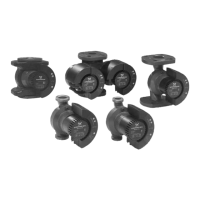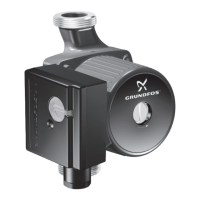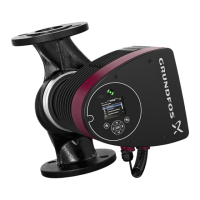19
8.3 Weight
8.4 Stroke volume
8.5 Materials
Pump housing material
• Pump housing: Al 226.
AR control unit enclosure
• Upper part of enclosure: PPO blend
• Lower part of enclosure: aluminium.
8.6 Data of contact pressure gauge for diaphragm
leakage detection (optional)
The contact pressure gauge has a reed switch with electrically
isolated contact output, maximum switching power 10 W for DC
current or 10 VA for AC current. The maximum switching voltage
is 100 V, maximum switching current 0.5 A.
The switching function is set up as an NC contact, i.e. if the
diaphragm breaks, the current circuit is interrupted.
The pressure gauge has a 2-metre cable.
9. Installation
9.1 General information on installation
9.2 Installation location
9.2.1 Space required for operation and maintenance
Maintenance work on the dosing head and the valves must be
carried out regularly.
• Provide sufficient space for removing the dosing head and the
valves.
9.2.2 Permissible ambient influences
• Permissible ambient temperature: 0 °C to +40 °C
(for an installation height up to 1000 m above sea level).
• Permissible air humidity: max. relative humidity:
70 % at +40 °C, 90 % at +35 °C.
9.2.3 Mounting surface
The pump must be mounted on a flat surface.
9.3 Mounting
• Mount the pump on a console or pump foundation using four
screws.
Pump type
Dosing head
material
Weight [kg]
Single
pump
Double
pump
DMH 251
PVC, PP, PVDF 11 13
Stainless steel
1.4571, 2.4610
13 17
DMH 252
PVC, PP, PVDF 11 13
Stainless steel
1.4571, 2.4610
13 17
DMH 253
PVC, PP, PVDF 12 17
Stainless steel
1.4571, 2.4610
14 21
DMH 254
PVC, PP, PVDF 27 32
Stainless steel
1.4571, 2.4610
32 42
DMH 255
PVC, PP, PVDF 55 63
Stainless steel
1.4571, 2.4610
65 83
DMH 257
PVC, PP, PVDF 56 88
Stainless steel
1.4571, 2.4610
68 112
Pump type
Stroke volume [cm
3
]
4 bar 10 bar 16 bar 25 bar
DMH 251 — 3.5 3.1 2.9
DMH 252 — 6.4 6.3 —
DMH 253 — 11.3 — —
DMH 254 — 31.6 30 —
DMH 255 — 60 — —
DMH 257 171 131 — —
Warning
Observe the chemical manufacturer's safety
instructions when handling chemicals!
Make sure that the pump is suitable for the actual
dosing medium!
Caution
The resistance of the parts that come into contact
with the media depends on the media, media
temperature and operating pressure. Ensure that
parts in contact with the media are chemically
resistant to the dosing medium under operating
conditions!
Note
Further information on resistance with regard to
the media, media temperature and operating
pressure is available on request.
Warning
Observe the specifications for the installation
location and range of applications described in
section 6. Technical data.
Warning
Faults, incorrect operation or faults on the pump
or system can, for example, lead to excessive or
insufficient dosing, or the permissible pressure
may be exceeded. Consequential faults or
damage must be evaluated by the operator and
appropriate precautions must be taken to avoid
them!
Warning
Risk of hot surfaces!
Pumps with AC motors may become hot.
Allow a minimum space of 100 mm to the fan
cover!
Note
A positive pressure difference of at least 2 bar is
required between the suction valve and the
discharge valve in order for the dosing pump to
operate correctly.
If the total counter-pressure (at the dosing point)
and geodetic height difference between the
suction valve and the dosing point is less than
2 bar (20 m WC), a pressure-loading valve must
be installed immediately before the dosing point.
Note
The pump must be installed in a position where it
is easily accessible during operation and
maintenance work.
Note
The installation site must be under cover!
Do not install outdoors!
Note
The flow must run in the opposite direction to
gravity!

